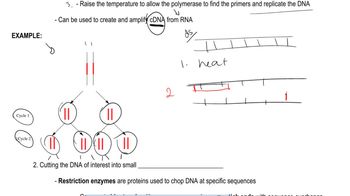Describe how having the Cas9 gene at a genomic locus unlinked to the guide RNA and target site locus in an engineered gene drive system could slow the propagation of the gene drive allele in a population into which a small number of individuals carrying both the gene drive allele and the Cas9 locus are released.
Table of contents
- 1. Introduction to Genetics51m
- 2. Mendel's Laws of Inheritance3h 37m
- 3. Extensions to Mendelian Inheritance2h 41m
- 4. Genetic Mapping and Linkage2h 28m
- 5. Genetics of Bacteria and Viruses1h 21m
- 6. Chromosomal Variation1h 48m
- 7. DNA and Chromosome Structure56m
- 8. DNA Replication1h 10m
- 9. Mitosis and Meiosis1h 34m
- 10. Transcription1h 0m
- 11. Translation58m
- 12. Gene Regulation in Prokaryotes1h 19m
- 13. Gene Regulation in Eukaryotes44m
- 14. Genetic Control of Development44m
- 15. Genomes and Genomics1h 50m
- 16. Transposable Elements47m
- 17. Mutation, Repair, and Recombination1h 6m
- 18. Molecular Genetic Tools19m
- 19. Cancer Genetics29m
- 20. Quantitative Genetics1h 26m
- 21. Population Genetics50m
- 22. Evolutionary Genetics29m
18. Molecular Genetic Tools
Genetic Cloning
Problem 33a
Textbook Question
The U.S. Department of Justice has established a database that catalogs PCR amplification products from short tandem repeats of the Y chromosome (Y-STRs) in humans. The database contains polymorphisms of five U.S. ethnic groups (African-Americans, European Americans, Hispanics, Native Americans, and Asian-Americans) as well as the worldwide population.
Given that STRs are repeats of varying lengths, for example (TCTG)₉₋₁₇ or (TAT)₆₋₁₄, explain how PCR could reveal differences (polymorphisms) among individuals. How could the Department of Justice make use of those differences?
 Verified step by step guidance
Verified step by step guidance1
Step 1: Understand the concept of Short Tandem Repeats (STRs). STRs are sequences of DNA consisting of repeating units of 2-6 base pairs. The number of repeats in these sequences can vary among individuals, creating polymorphisms (genetic variations). For example, one person might have (TCTG)₉ repeats, while another might have (TCTG)₁₇ repeats.
Step 2: Learn how PCR (Polymerase Chain Reaction) works. PCR is a technique used to amplify specific DNA sequences. Primers are designed to flank the STR regions, allowing the amplification of these regions. The size of the amplified product will depend on the number of repeats in the STR region.
Step 3: Understand how differences in STR lengths are detected. After PCR amplification, the products are typically analyzed using gel electrophoresis or capillary electrophoresis. These techniques separate DNA fragments based on size, revealing the length of the STR region for each individual.
Step 4: Explore how STR polymorphisms can be used for identification. Since STR lengths vary greatly among individuals, they serve as a genetic fingerprint. Comparing STR profiles can help identify individuals or determine familial relationships.
Step 5: Consider the application by the Department of Justice. The database of Y-STR polymorphisms can be used in forensic investigations to match DNA samples from crime scenes to suspects or to identify unknown individuals. Y-STRs are particularly useful in tracing paternal lineage, as they are inherited from father to son without recombination.
 Verified video answer for a similar problem:
Verified video answer for a similar problem:This video solution was recommended by our tutors as helpful for the problem above
Video duration:
2mPlay a video:
Was this helpful?
Key Concepts
Here are the essential concepts you must grasp in order to answer the question correctly.
Short Tandem Repeats (STRs)
Short Tandem Repeats (STRs) are repeating sequences of DNA, typically 2-6 base pairs in length, that vary in number among individuals. These variations, or polymorphisms, can be used as genetic markers for identification purposes. STRs are particularly useful in forensic science and population genetics because they are highly variable and can provide a unique genetic profile for individuals.
Recommended video:
Guided course

Duplications
Polymerase Chain Reaction (PCR)
Polymerase Chain Reaction (PCR) is a molecular biology technique used to amplify specific DNA sequences, making millions of copies of a targeted region. This process involves repeated cycles of denaturation, annealing, and extension, allowing for the analysis of small amounts of DNA. In the context of STRs, PCR can selectively amplify these regions, enabling the detection of variations that distinguish individuals.
Recommended video:
Guided course

Genetic Cloning
Forensic Applications of Y-STRs
Y-STRs are specific to the Y chromosome and are inherited paternally, making them particularly useful in forensic investigations involving male lineage. The U.S. Department of Justice can utilize the polymorphisms found in Y-STRs to create genetic profiles that help identify suspects or victims in criminal cases. By comparing Y-STR profiles from crime scene evidence to those in the database, investigators can establish familial relationships or link individuals to specific populations.
Recommended video:
Guided course

Sex-Linked Genes
Related Videos
Related Practice
Textbook Question
458
views


